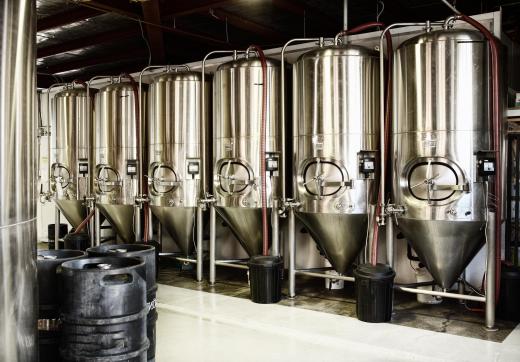Industrial fermentation is the same process household bakers use when applying yeast to bread, but on a much larger scale. This procedure ferments certain materials into useful products by using microorganisms, carbon, nitrogen, oxygen and an energy source to power the fermentation. This is commonly done for food products, but industrial fermentation also is done in the pharmaceutical industry and in sewage disposal. The largest difference between regular fermentation and the industrial variety is that large fermenter units are used to produce large-scale fermentation.
Fermentation, whether it is household or industrial fermentation, is the act of oxidizing organic compounds to produce a new component. To create this effect, several natural elements must be present. Fermentation requires a carbon source, such as sugar; a nitrogen source, such as protein or nitrates; oxygen; and a source of energy such as heat or pressure. When these combine, the natural fermentation process breaks down a materials components and changes them into something useful.

Industrial fermentation for food is one of the most obvious uses of fermentation. All alcohols require fermentation for the alcohol to develop. Cheese requires that dairy products be aged and fermented before they take on the properties of cheese. There also are many baking applications, such as making most breads, which also require fermentation.
The pharmaceutical industry requires fermentation for the creation of many medicines. For example, all antibiotics based on penicillin require the fermentation of penicillin to make the antibiotic effective. The same is true for engineered hormones such as insulin and medical steroids, and vitamins and amino acids in protein bars.

Sewage disposal makes use of industrial fermentation by breaking down solid sewage into harmless materials that can be used as fertilizer. Bacteria are introduced to sewage and begin to eat away at it until the sewage is soluble and harmless. While effective, sewage fermentation takes a long time.
When comparing industrial fermentation to other forms of fermentation, there is very little difference, because both make use of the same biological processes. Most commonly, industrial-scale fermentation makes use of a machine called a fermenter, which is big enough to fit large amounts of components. These machines are made to keep the materials under the correct conditions to ensure fermentation occurs on a continual basis. Fermenters are used most often with pharmaceutical fermentation, but baking fermentation also uses the equipment.
